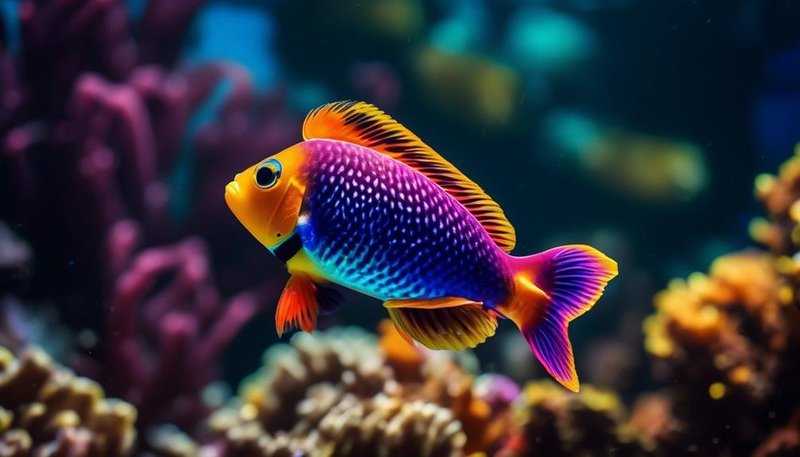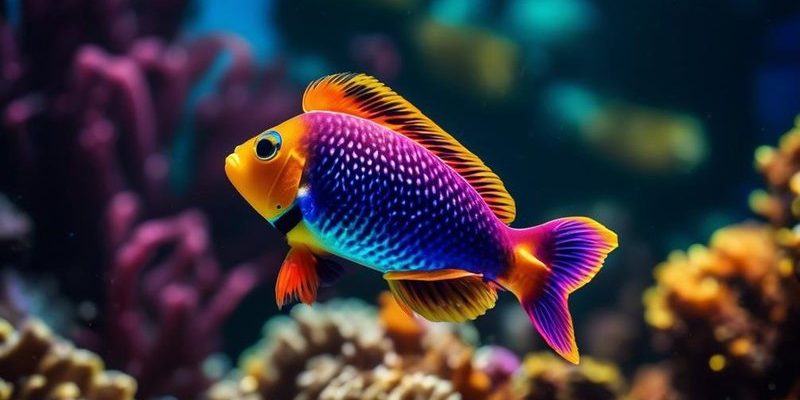
Dottybacks belong to the family Pseudochromidae and come in various species, with the purple dottyback being one of the most well-known. Imagine a fish that not only brings color to your tank but also a bit of character and charm. They’re a small, go-getting fish, often showing off their vibrant hues and playful antics. Think of them as the energetic, curious friend who always seems to be up to something, eager to explore and make their presence known.
Understanding the behavior and temperament of dottybacks is crucial, especially if you’re considering adding one to your aquarium. Their spirited nature means they can both entertain and challenge aquarists. So, just like any good conversation over coffee, let’s break down what makes dottybacks unique, pulling back the curtain on their quirky nature.
What Is a Dottyback?
You might be asking, “What exactly is a dottyback?” Dottybacks are small marine fish commonly found in coral reefs across the Indo-Pacific region. These little swimmers typically grow to about 3 to 4 inches in length, making them perfect for home aquariums. Their stunning colors range from vibrant blues and purples to yellows and oranges, instantly captivating anyone who lays eyes on them.
There are several species of dottybacks, each with its own unique traits and colors. For instance, the purple dottyback stands out with its deep purple body and striking yellow fins. These fish are usually quite hardy, which is great news for beginners, but they do come with specific needs that any owner should be aware of.
When choosing a dottyback for your aquarium, keep in mind their territorial nature. They may not play well with everyone, especially larger or more aggressive tank mates. This can lead to some exciting dynamics in your aquatic ecosystem, but it’s essential to understand how to maintain harmony among your fish.
Personality Traits of Dottybacks
Here’s the thing: dottybacks are known for their distinct personalities. They’re not the type of fish that will just sit around all day. Instead, they’re curious, active, and often quite bold. You might even say they have a bit of a “big fish in a small pond” attitude, always ready to explore their surroundings.
Dottybacks are typically solitary creatures, preferring to stake their claim on a specific territory in the tank. They often enjoy hiding among rocks or coral, where they can peek out at the world. If you’ve set up your aquarium with plenty of caves and crevices, you’ll likely see them darting in and out. This behavior not only keeps them stimulated but also provides them with a sense of security.
As lovely as their colors and movements might be, you might wonder how their personalities affect their interactions with other fish. Here’s where things can get a bit tricky: while dottybacks can be kept with a variety of fish, they can also be quite territorial. This means they might chase away other fish that come too close to their coveted hiding spots. So, if you’re thinking about adding a dottyback, be mindful of your tank mates!
Social Behavior in the Aquarium
When it comes to social behavior, dottybacks can be a mixed bag. They have a reputation for being somewhat aggressive, particularly toward other dottybacks and similar-sized fish. If you decide to keep multiple dottybacks in the same tank, be sure to provide plenty of space and hiding spots to minimize conflict. It’s like hosting a party—you want to ensure everyone has room to mingle without stepping on each other’s toes.
In a community tank, dottybacks might act as the social butterflies, zipping around and showing off their vibrant colors. However, they can also be the bouncers, guarding their territory and reminding others who’s in charge. This means it’s essential to monitor their interactions closely, especially during feeding time when competition can flare up.
Interestingly, when kept alone, dottybacks tend to be more relaxed and confident. You’ll often see them swimming openly, exploring their environment without fear. But add a tank mate that they perceive as a rival, and you might witness a different side—one filled with defensive posturing and swift movements. It’s a fascinating transformation, showing just how much their environment can influence their behavior.
Feeding and Foraging Behavior
Feeding time is always an exciting event in an aquarium, and dottybacks are no exception. These fish are carnivorous, so they thrive on a diet rich in protein. In the wild, they usually munch on small crustaceans, zooplankton, and other tiny morsels. When kept in a tank, you can offer them high-quality pellets, frozen foods, and even live food.
Dottybacks have a unique way of foraging, often employing quick bursts of speed to catch their meals. They’ll dart in and out of hiding spots, using their agility to snatch food. You might find them hovering near the bottom of the tank or darting around rocks, showcasing their keen hunting instincts.
A well-fed dottyback will display vivid colors and an energetic demeanor. Conversely, if they’re not getting enough to eat, they might become lethargic or stressed. To avoid such issues, make sure you’re providing a balanced diet and feeding them appropriately. Remember, these little fish have big appetites, so don’t skimp on the food!
Territorial Behavior and Conflict Resolution
Now, let’s talk about one of the most notable aspects of dottybacks: their territorial behavior. As mentioned before, these fish tend to be quite protective of their space. If they perceive another fish as a threat, they’re not afraid to show off their aggressive side. This can lead to some pretty intense standoffs in the tank, especially if you have several similar-sized fish.
If you’re dealing with aggression, it’s crucial to have an action plan. Start by ensuring there are plenty of hiding spots and territories for each fish. Rearranging decorations can sometimes help break any established territories, giving everyone a fresh start.
Should conflicts arise, don’t panic. Observing the interactions is key. If one fish seems to be bullying another, you may need to separate them temporarily. Keeping a close eye on their behavior will help you figure out the best course of action. Sometimes, it’s as simple as giving them a little more personal space.
Choosing the Right Tank Environment
Creating the ideal environment for a dottyback is crucial to ensuring it thrives. These fish prefer a well-structured tank with plenty of hiding spaces. Think rocky formations, caves, and even some live plants that can provide shelter. A well-planned aquascape not only enhances the aesthetics of your aquarium but also caters to the natural instincts of your dottybacks.
Water quality is equally important. Dottybacks thrive in stable conditions with a temperature between 72°F and 78°F (22°C to 26°C), a pH of 8.1 to 8.4, and salinity ranging from 1.020 to 1.025. Regular water changes and monitoring are essential to keep these parameters in check.
Lastly, consider tank size. While dottybacks are small, they appreciate a bit of space to swim around. A tank of at least 30 gallons is ideal for dottybacks, especially if you plan to house them with other fish. More space means less chance of overcrowding, which can lead to conflict and stress.
Final Thoughts on Dottyback Behavior
In summary, the behavior and temperament of dottybacks can be both enchanting and challenging. Their vibrant personalities and bold nature bring life to any aquarium, but they also require careful consideration regarding tank mates and environment. You might find their antics amusing as they explore their territory, making them a favorite among aquarium enthusiasts.
By understanding their unique traits, you’ll be better equipped to create a thriving environment for your dottyback. With the right care, you’ll have a colorful and spirited fish that adds character to your underwater world. So, whether you’re a seasoned aquarist or a newcomer, consider making a dottyback part of your aquatic family—you might just find their energy infectious!

